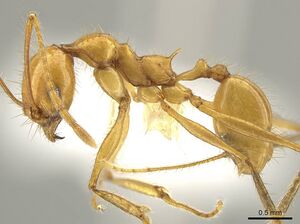Pheidole tinamu
| Pheidole tinamu | |
|---|---|

| |
| Scientific classification | |
| Kingdom: | Animalia |
| Phylum: | Arthropoda |
| Class: | Insecta |
| Order: | Hymenoptera |
| Family: | Formicidae |
| Subfamily: | Myrmicinae |
| Tribe: | Attini |
| Genus: | Pheidole |
| Species: | P. tinamu |
| Binomial name | |
| Pheidole tinamu Longino, 2019 | |
This species occurs in montane wet forest. Most collections are from ground baits. A few are in Winkler samples of sifted litter and rotten wood, and rare workers occur in Malaise and beating samples.
Identification
Minor: face smooth and shining; head somewhat tapering posteriorly; occipital carina weakly developed; promesonotal groove present, distinctly impressed; lateral pronotum smooth and shiny; katepisternum uniformly foveate; propodeal spines long, similar in length to posterior face of propodeum; gaster smooth and shining; abundant, flexuous, erect setae on mesosomal dorsum, tibiae, and gastral dorsum; color yellow.
Major: inner hypostomal teeth widely spaced, in form of short points, in front of outer hypostomal teeth; scape base subterete, narrower than apical portion; head heart-shaped in face view; face with oblique, subparallel rugulae anteriorly, posterior two thirds of face smooth and shining; promesonotum strongly produced, with promesonotal groove shallow to absent; propodeal spines about half length of posterior face of propodeum; gastral dorsum faintly foveolate on anterior half; abundant, erect, somewhat bristly setae on face, sides of head, mesosomal dorsum, tibiae, and gastral dorsum.
Measurements, minor worker: HW 0.72, HL 0.93, SL 1.29, EL 0.18, WL 1.23, PSL 0.2, PTW 0.15, PPW 0.22, CI 77, SI 179, PSLI 27, PPI 148 (n=3).
Measurements, major worker: HW 1.88, HL 1.86, SL 1.3, EL 0.26, WL 1.77, PSL 0.18, PTW 0.32, PPW 0.49, CI 101, SI 70, PSLI 10, PPI 155 (n=2).
On the slopes above the Rio Savegre in Costa Rica there are three sympatric species, all of which have very similar minor workers that are large, yellow, and with long propodeal spines. Relative to P. tinamu, the minor worker of Pheidole familiaparra has a more strongly developed occipital carina, and the minor of Pheidole savegre has coarser, darker setae. The major worker of P. tinamu has a heart-shaped head and the promesonotum is strongly produced, with shallow promesonotal groove. The other two species have the head with convex sides but not clearly heart-shaped, and the promesonotal groove is impressed.
A minor worker from the Wilson Botanical Garden is tentatively identified as this species. This is a similar montane wet forest site, less than 130 km south of the Rio Savegre collections.
A minor worker from Santa Maria de Dota was part of the syntype series of P. biolleyi subsp. tristani, a junior synonym of Pheidole biolleyi. A major worker from Cartago was designated Lectotype (see under P. biolleyi), excluding this minor worker.
Distribution
Latitudinal Distribution Pattern
Latitudinal Range: 9.48895° to 9.48141°.
| North Temperate |
North Subtropical |
Tropical | South Subtropical |
South Temperate |
- Source: AntMaps
Distribution based on Regional Taxon Lists
Neotropical Region: Costa Rica (type locality).
Distribution based on AntMaps
Distribution based on AntWeb specimens
Check data from AntWeb
Countries Occupied
| Number of countries occupied by this species based on AntWiki Regional Taxon Lists. In general, fewer countries occupied indicates a narrower range, while more countries indicates a more widespread species. |

|
Estimated Abundance
| Relative abundance based on number of AntMaps records per species (this species within the purple bar). Fewer records (to the left) indicates a less abundant/encountered species while more records (to the right) indicates more abundant/encountered species. |

|
Biology
During sampling in 2015, as part of the ADMAC project, P. tinamu was common at 1000 m elevation and less abundant at 800 m. Pheidole familiaparra occurred occasionally at 800 m. Pheidole savegre occurred occasionally at 800 m and 500 m.
Castes
Worker
Minor
Images from AntWeb
   
| |
| Paratype. Worker (minor). Specimen code CASENT0646317. Photographer Michele Esposito. | |
Nomenclature
The following information is derived from Barry Bolton's Online Catalogue of the Ants of the World.
- tinamu. Pheidole tinamu Longino, 2019: 61, fig. 54 (w.) COSTA RICA.
Type Material
- HOLOTYPE: 1 major worker, Costa Rica, San José: Cerro Plano, 9.48446 -83.96228 ±200m, 1030m, 6-Jul-2015, cloud forest, at bait (ADMAC, Ba-E-06-2-03-16) [MUCR, unique specimen identifier CASENT0646320].
- PARATYPES: major, minor workers: same data as holotype except 9.48141 -83.96276 ±200m, 1070m, (Ba-E-06-1-04-09) [MCZC]; 9.48141 -83.96276 ±200m, 1070m (Ba-E-06-1-04-11) [CAS]; Ranchos Tinamu, 9.48568 -83.95673 ±100m, 850m, 13-Jul-2015, montane wet forest, in matrix of pasture and forest, probably old 2nd growth, at bait (Ba-E-08-1-01-05) [USNM]; (Ba-E-08-1-01-07) [DZUP]; 9.48895 -83.95624 ±100m, 760m, near streams, at bait (Ba-E-08-2-02-04) [JTLC].
Description
Etymology
Named for Ranchos Tinamu, the ecolodge that hosted us during sampling at the type locality.
References
References based on Global Ant Biodiversity Informatics
- Longino J. T. 2019. Pheidole (Hymenoptera, Formicidae) of Middle American wet forest. Zootaxa 4599: 1-126

